(Updated 2022-03-08: links to JT-Alert tutorial, K4 setup tutorial; added links to Meinberg NTP and Grid Tracker; updated screenshots of PSK Reporter & WSJTX 2.5.4)
Download and install the latest distribution from the WSJT-X project page. The documentation is well-written and useful.
Please, pretty please, verify your system clock is set accurately. Seriously. The FT8 cycles are 15 seconds, of which 12.6 seconds are transmit, 0.5 – 1 seconds of decode & lookup, and the rest left up to you to make a response. On Mac, this is done via command-line:
sudo ntpdate -u time.apple.com
As David (ac0vh) notes, MacOS 10.14 or newer:
sudo sntp -sS time.apple.com
On Windows, you can usually force it by selecting the “Adjust time and date.” It’s been suggested that Meinberg’s NTP download may work better. (NTP = Network Time Protocol) or use Dimension 4. If you have access to a GPS Dongle emitting NMEA format, you can use VisualGPS’ NMEATime2 to synchronize time. (Do be aware that the Windows machine going to sleep and powering down the GPS device will cause issues.)
Edit the preferences. In the General tab:
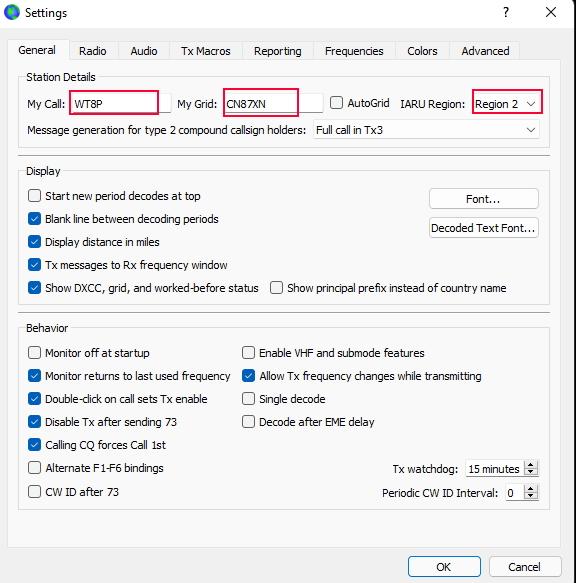
1. Enter your call sign.
2. Enter your Maidenhead grid.
3. This is optional, but if you choose your IARU region, it’ll help set up your frequency list later.
(optional) I like the program off by default as a reminder to set my system time. I also will disable transmit after sending the 73.
The Radio tab is going to vary depending on what you own.
For the Elecraft K4, there is a more detailed tutorial here.
For my Elecraft KX3: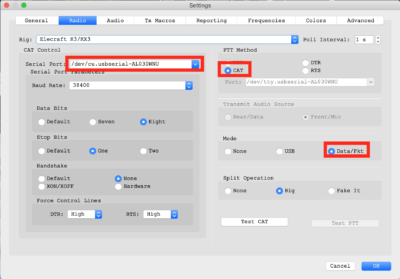
1. USB device for the control cable.
2. The computer controls the radio rather than using tones (like my HT does).
3. This tells the radio to use data mode, which disables compression, the RX/TX EQ, and uses a low error-rate ALC.
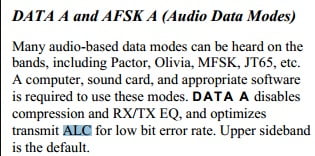
My Mac lacks a microphone, so I use an external USB dongle for both in and out. Generally, you want to use as little volume as necessary to avoid overloading the card.
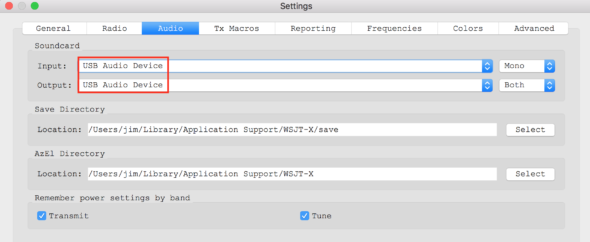
The Elecraft radios need ALC (Automatic Level Control) gain on the radio -showing 4-5 bars. Some radios (e.g., ICOM) will require this off. Sound out from the radio (and into the sound card) is kept at a minimum. See below.
The reporting tab has several items of interest:
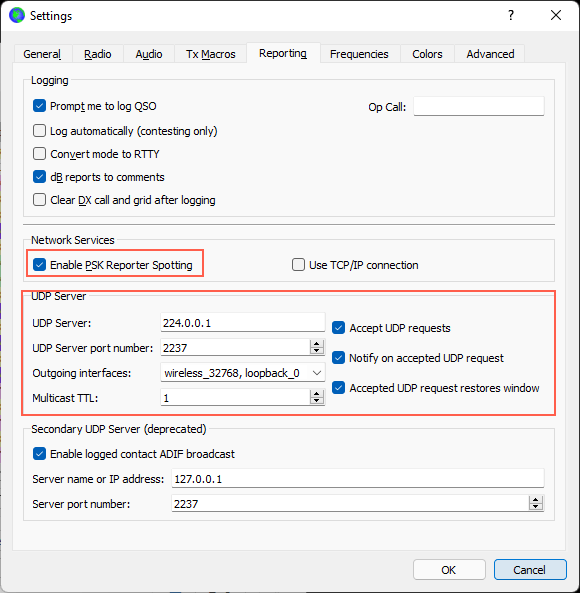
Enable PSK reporter Spotting will upload data to a (free) spotting service This is very useful because it lets you see that your station is being received. It’s also helpful to try the “grid square” option to see what’s being received from your home. Below shows stations heard from CN87 on 2022-03-08 at 17:20z:
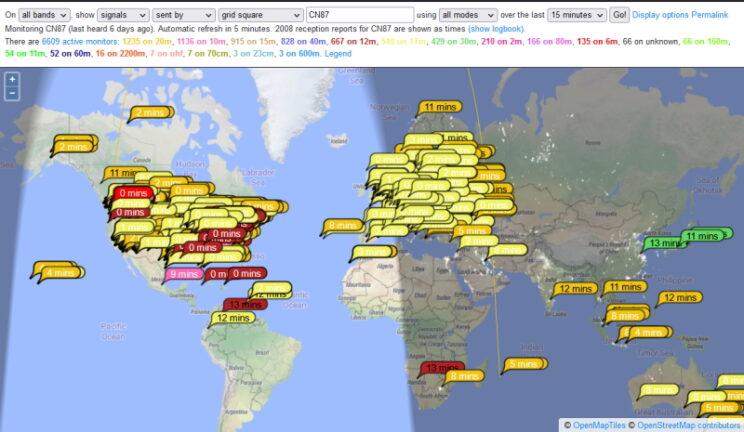
In the second block, you can enable local broadcast (in this case, multicast) so complementary utilities can listen for things and perform useful actions such as automatically logging. On the Mac, JT-Bridge act as a layer to do lookups then instruct MacLoggerDX to upload them to QRZ.com. (Yes, this is overly complex.)
On Windows, JT-Alert to act as the bridge and also let you know if there is a geographical entity you need. W6AER has a useful tutorial on using them both. If you like maps, take a look at Grid Tracker.
Finally, the first time you use wsjtx, or if you update, you’ll need to load in frequencies. Right-click on the main window and select Reset. I skim through these to remove bands my radio doesn’t support (e.g., 2200m, microwave frequencies):
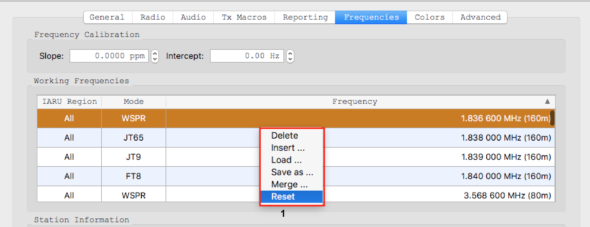
Right click and save these just in case you want to start over.
Okay, now that that’s set up, in the main window, there are four areas of interest:
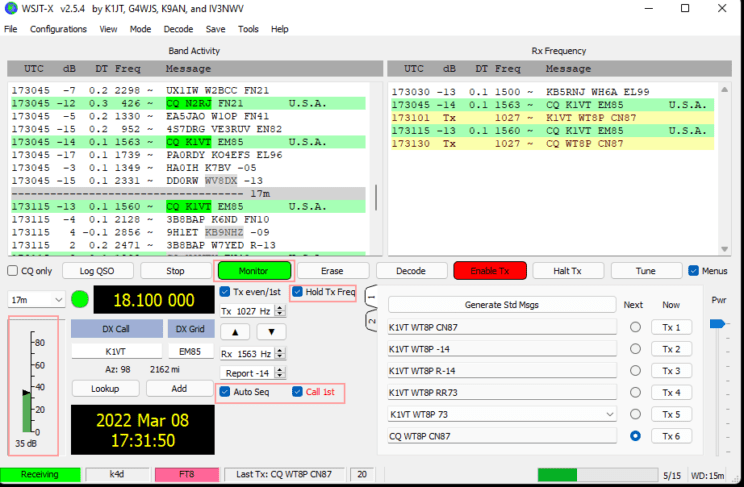
- Select the “Monitor” button to start listening. The waterfall should start showing activity if there are users on. Once a full 15-seconds has elapsed, you should start seeing those signals being decoded. (On this display, I set the spectrum to 0% and then turn off the controls.)

2. On the bottom, left is a meter showing input levels. You want it to be in the green, ideally around 25-40db. If it’s too quiet, the bar will be yellow meaning you’re not getting enough signal. If it’s too loud, the bar will turn red indicating oversaturation.
3. Etiquette is that you try not to tromp over an existing user. Once you’ve staked out a spot, use the “Hold Tx Freq” button to stay there. Otherwise, your response will be jumping all around to the responder. (The only case I’ve found this to be helpful is if you have a QSO in progress that doesn’t seem to be completing, sometimes switching to the other person’s frequency can help. The problem is people forget to move back off that.)
4. The other two tick boxes are assistive automation. Auto Seq will progress through the calling sequence on each cycle. It’s necessary on FT8 because of the rapid cycle times (and my lack of cat-like reflexes). The Call 1st is used when you’re calling CQ – it will automatically select the first response (either by time or, in the event of a tie, the sub-frequency you’re monitoring followed by the order of sub-frequency).
If there is a lot of activity on the band, you may want to tick the “CQ Only” box in the left, middle.
The standard messages, on the bottom, right, are automatically generated when you respond to someone (by double-clicking on their CQ) or someone responds to you.
So now, here’s how a sequence works. The top quarter and bottom half of the graphic below are WSJT-X. Sandwiched in the middle is a third-party listener, JT-Bridge (or JT-Alert), that does lookups of people and lets me know if they’re in a geographic area of interest.
First, I have the Monitor button (in green) selected, so it’s listening. On the waterfall graph, outlined by the red rectangle are 15-second bursts of transmissions from NA4M calling CQ. To response, I double-click on the CQ at 02:05:45. (With JT-Bridge, I can also click on the one with the little number “3” next to it).
That action does the following things:
a) Pre-loads a set of standard messages (shown below) for the exchange.
b) Enables transmit (the Enable Tx button, currently off, because I’m doing this post-exchange)
c) Populates the Rx Frequency side with what’s happening on my receive frequency.
You’ll see in step (2), I respond, but he doesn’t acknowledge. He repeats his CQ 30 seconds later. I respond in step (3). When he acknowledges me with my signal strength in step (4), the line turns purple to let me know that someone’s talking with me. At that point, I return back to him with R-09 signal strength. At step (5) he acknowledges receipt, and then exchange regards.
This is the older, JT-Bridge sequence:
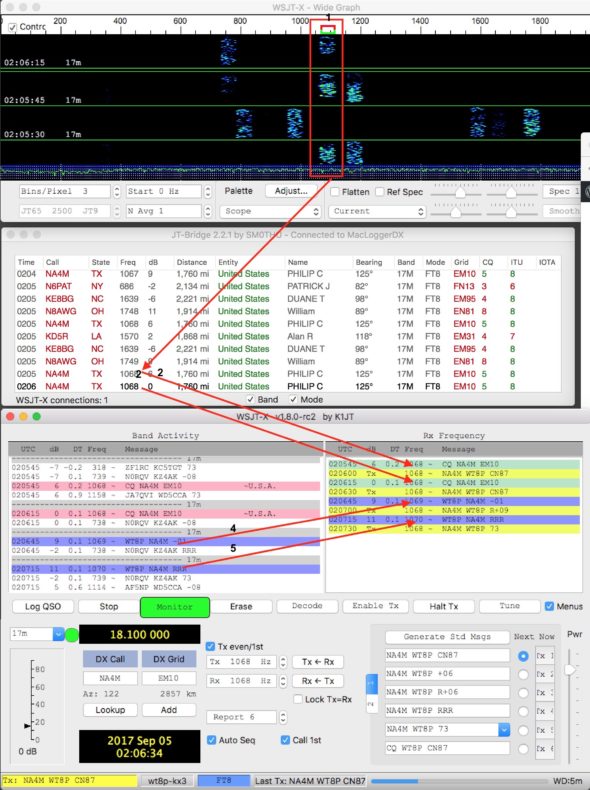
For an advanced tutorial on FT8, DXpeditioner Rob (N7QT) presented to the Spokane DX Club in September 2021. One of several useful things I learned is double-clicking on the TX1 button to forgo sending grid and double-clicking on the TX4 button will send RR73 instead of separate RRR and 73 sequences. When conditions are good, this can speed up contact from ~2 minutes to ~1 minute, sh own below. (JT-Alert is in the middle, decoding. I have assigned transmissions to me to appear in purple.)
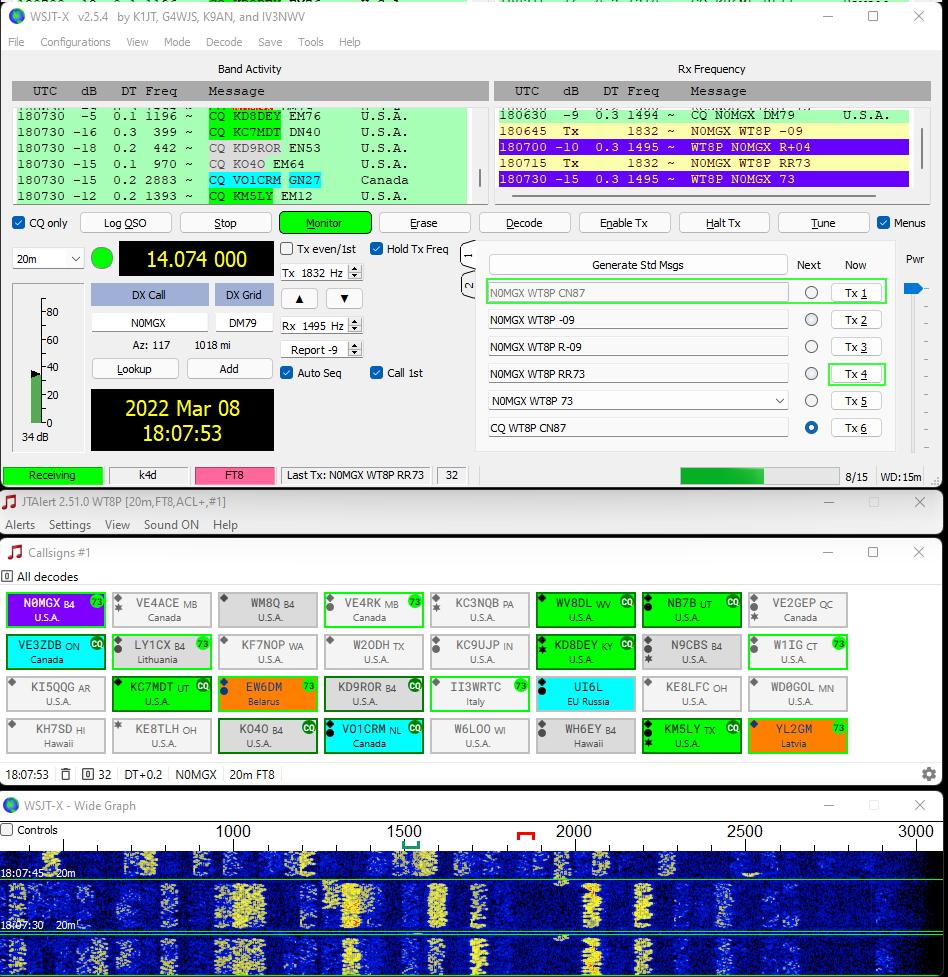
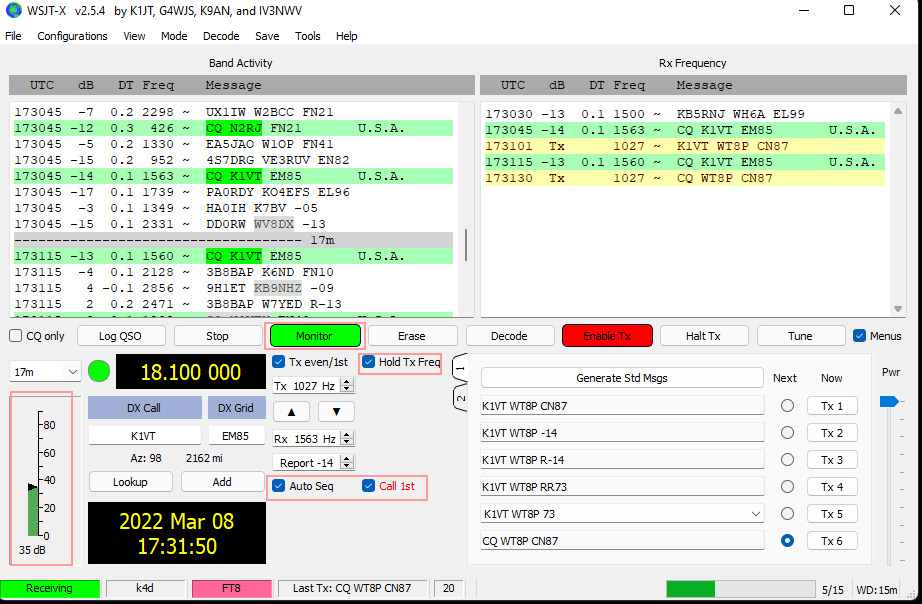
Hello Jim,
Thank you for this information website about WSJT-X and his setup.
73 de ON6AT Patrick
How do I manually insert a call sign I wish to contact? ie. I see a QSO with a DX station that is listed on the left side of the RX window. I want to copy or input that station in my right hand window. I have been copying and pasting then manually changing all the responses to reflect the station I’m trying to contact.
You can’t. Those ‘left side’ call signs are being decoded by others, not you. When YOU decode a station, it will ‘right side.’ Manually setting up a standard message to call a left side station is fruitless — you’re not decoding him.
I am not sure that “‘left side’ decodes are by others. I think that all the decodes are done locally.
Regards Martin
Thanks for an explanation that makes sense to a newbie.
Tom KJ9P
Very helpful sir. Would you please let me know all the radio “width” settings and all of the radio settings best suited for FT8?
Matt – most folks use 2.5KHz. If I’m trying to reach someone whose signal is really difficult to hear, because there’s a nearby strong signal, I’ll use the notch filters to refine it.
DE KB3SVJ John: Jim, Thanks so much for the easy to understand set up guide. I’m new to digital and the Official guide was over my head.
Hi, I have FT8 all set up using a hp computer K3 and an outboard sound card. It’s receiving great and PTT keys the rig, but I’m not getting any output from the computer to the rig on transmit?
Tom – my initial guess is the volume is not high enough to drive the radio. On the bottom, right of the WSTJX screen is a little slider that you can use to adjust the output from the app. Failing that, you may also try bumping up the output volume a little bit and also verifying that the device is correct. (For my KX3, I use CAT control rather than PTT.)
I’m using an outboard sound card. Still not getting anything out of the computer??
Tom try setting vox instead of cat in the radio tab. That worked for me.
Jim
Thanks for the helpful info. I use a Mac and finally figured out how to use the internal log. How ever I have a list of about thirty previous contacts that I would like to add to the log. Do you know how to do that?
Oh2EUU Pete
Installed and set up FT8 yesterday Everything works until my third message is sent, after that it does not progress to the final messages, but repeats sending the third message over and over
I couldn’t quite figure out, or at least wasn’t sure.
Are you driving the KX3 directly over USB and not using a signallink/similar usb sound card?
Is there one USB cable between your KX3 and computer or two?
Even with 100 watt no one answers my calls. I get it perfectly, but when I give a clik nobody answers The clock is right. The ALC is correct, I leave in USB but the program does not decode.
Thank you very much. Milton PY2CYE
Can I run a jack to jack leads from pc to KX3. audio out, Mic in,
directly.
Jol – Yes you can. The USB dongle is the alternative for those who con’t have a MIC in connection to our computers.
73, Jim
Just followed your guide. My Mac doesn’t have a mic port either so I’m using a usb sound card.
Ive got a programming cable plugged in to the radio (857D) and the software can control the radio.
I have no micro phone port so I’m using usb sound card .
I run a cable from audio jack from the radio to microphone in and I can decode signals.
Do I need another cable from the usb sound card to the back of the radio?
If I do can you recommend one
73’s jez
I can’t get the color tab to function. That is, colour call signs that I have already had contact with. With default settings just get green, red, yellow. Clicked load ADIF file but nothing changes. Can you help please? Using Win and WSTJ-X v2. Thank you!
I am using a MacBook Pro, an Icom 7300, and WSJT-X 2.0.1 Darwin. Everything looks good except no power out and a loud tone comes from the MacBook speaker. I looked at the Audio tab in Preferences and I don’t have a choice of Audio Codec, just internal microphone, etc. I own a SignaLink USB interface but am not using it. Someone told me that with a 7300, a Signalink is not needed. I am confused/frustrated. Can you help please? Thank you. –Stu WA6BTK
Sorry for taking up time on this site, but I have another problem. Since installing either the WSJT-X or the driver (not sure when this problem started), the 7300 will abruptly shut itself off for about two seconds. The the 7300 will turn itself on again and be fine for roughly 10 minutes and then will shut itself off again. Do you have any idea what’s happening? Thank you, again. –Stu
I did a full reset on the 7300 and the off/on/off problem seems to have gone away. But the hamlib connect error still remains. I looked at the NO5V tutorial and I’m set the way the video shows.
My first try at WSJT-X FT8 and when everything is up and running, the KX3 goes into split mode. Is this correct? If not. how do I change it?
Split mode is normal when your TX frequency (the red goalpost) is towards the left or right sides of the waterfall. It’s not easy to explain why … but I’ve tried, with a diagram: see page 20 of the FT8 Operating Guide (https://bit.ly/FT8OP).
73
Gary ZL2iFB
Jim, thanks for your tutorial on ft8. I am almost there on getting things working. My problem at this point is whenever I double click on a call sign in either window (band activity or Rx frequency) the program closes.
I am using WSJT-X v 2.1.0, on an iMac, with a Signalink USB, to a Yaesu 450-D.
Thanks in advance for any insight you may have.
Mike Cox KI5DF
Mike – When it crashes, do you get a stack trace of any kind – that may narrow it down.Things I’d look at (which you probably have) – version of the OS (needs to be 10.10 or higher). THe signalink should be plug and play, but it would be worth double-checking that WSJTX is showing it as an audio device for input and output.
Thanks for the tutorial Jim!
In the event someone is running 10.14 or newer macOS/OS X the command to synchronize your machine’s clock has changed.
“sudo sntp -sS time.apple.com”
73,
David
Why wont it let me send my grid square when I run portable. Ex. NE8O/4
thanks for tutorial .
I have a problem with my FT8 setup. I m using SCU 17 interface with Yaesu FT DX 1200 . The setting done but FT8 does not decode. What should I do ?
Thank you in Advance